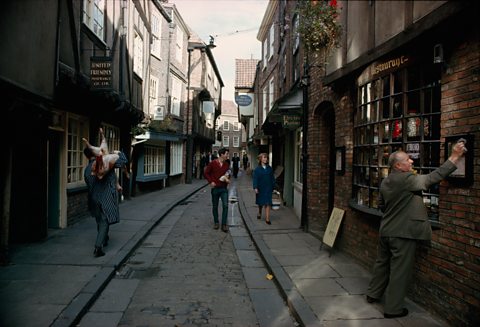Public health in the medieval period
Medieval towns were unhealthy places. Public health was not high on the agenda of most town councils. Towns did not have sewage systems or supplies of fresh water, and probably smelled quite awful as garbage and human waste were thrown into the streets.
Houses were made of wattle and daub A building material used for making walls, consisting of a lattice of wooden strips plastered with mud. and overhung the streets, cutting out light and air. Rats, lice and fleas flourished in the rushes strewn over the clay floors of people's houses. It is hardly surprising that disease thrived in medieval towns.
The Shambles in York was once a street of butchers. Some houses still have hooks outside where meat was displayed.

Contrary to popular opinion, most medieval people realised the importance of personal hygiene.
However, cleanliness was a luxury few could afford. Most people washed in cold water unless they were rich and could afford to have it heated.
By the later Middle Ages there was a growing awareness of the importance of hygiene, and municipal authorities were spending money on trying to keep their cities clean.
- Towns began to build provided public latrines (toilets). By the 15th century, London had over a dozen. They were often placed on bridges, so that the waste could be taken away by the river.
- London produced about 50 tons of excrement per day, so muck-rakers were hired to clean the streets. They were paid much better than the average working man. There were also gong farmers who cleared out cesspitAn underground pit used for collecting human excrement. and latrines.
- Towns had bath houses, eg Southwark, in London, had 18 hot baths. Even smaller towns would have bathhouses, often connected to bakeries вҖ“ the baths used the heat coming from their ovens to heat their water.
- Many towns introduced quarantineA period of time during which a person is isolated due to a contagious disease - to prevent the disease being passed to other people. laws to combat plague, and boarded up the houses of infected people. People with leprosy, likewise, were confined to lazar houses.
- During the Middle Ages the crusaders brought back soap from the Middle East to Europe.
Most monasteries were on the outskirts of towns or in the countryside, and they observed strict rules about cleanliness. They had fresh running water, 'lavers' (wash rooms), flush 'reredorters' (latrines) connected to sewers, clean towels and a compulsory bath four times a year.
Sanitation was thought important. Small towns like Kenfig, in Wales, had public health regulations. Dumping refuse inside the town or close to its walls was an offence and residents were told to clean the pavements in front of their houses.
Butchers were not allowed to slaughter animals in the street and were fined if they threw offal into the street. To keep the townspeople healthy, there were also strict rules about the quality of food sold by traders.
However, the biggest fines were reserved for those who disrupted business, eg 3 shillings (15p) for fighting or 5 shillings (25p) for playing tennis in the street, perhaps indicating that, for the corporationThe committee of people who ran the town, very much like a medieval council., there were more important things than public health.
The Government took steps to try to improve public health and hygiene and issued a fine of ВЈ30, which was huge for this period. This law passed by parliament after the Black DeathA disease that spread across Europe killing up to half of the population.in England (1348-1350) shows its concern.
... so much dung and filth of the garbage and entrails be (are) cast and put into ditches, rivers, and other waters... that the air there is grown greatly corrupt and infected, and many maladies and other intolerable diseases do daily happen... all they who do cast and lay all such annoyances, dung, garbages, entrails, and other ordure, in ditches, rivers, waters, and other places aforesaid, shall вҖҰforfeit to our Lord the King the sum of 20 pounds.
However, in spite of the efforts listed above, there is no evidence of any real improvement in public health during the Middle Ages.
- People had no knowledge of the causes of disease. The extract above refers to idea that disease was spread by miasmaSmells from decomposing material, such as animal and human waste, that were thought to cause disease. when it states
the air there is grown greatly corrupt and infected
. - Public latrines emptied into rivers which became breeding grounds for disease. People used water from rivers to cook and clean.
- The volume of rubbish meant that it was almost impossible to keep streets clean.
- Even in towns with bath houses, people did not bathe that often. One medical book advised people that spring and winter were good times for bathing, but that it should be avoided in the summer.
- Improving public health was not seen as a Government responsibility.
- The Church taught that disease was GodвҖҷs punishment, so people believed that nothing could be done about it.